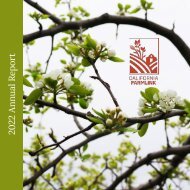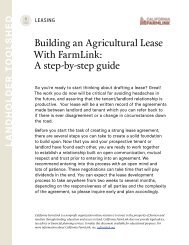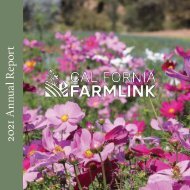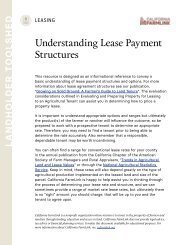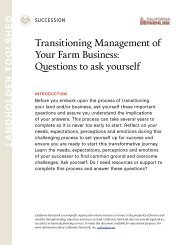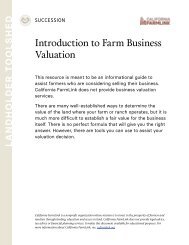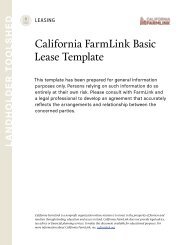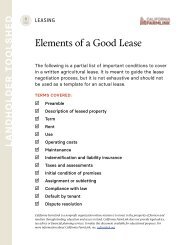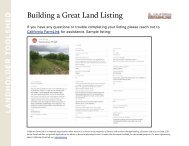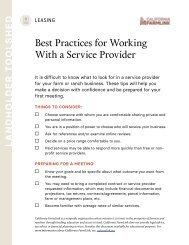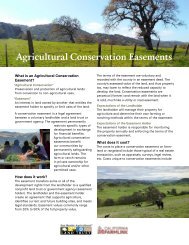Guide to Regenerative Grazing Leases: Opportunities for Resilience
California FarmLink and TomKat Ranch Educational Foundation teamed up to create this resource focused on land leases that support regenerative grazing practices. This guidebook aims to empower private, nonprofit, and public landholders, as well as easement-holders and grazing tenants.
California FarmLink and TomKat Ranch Educational Foundation teamed up to create this resource focused on land leases that support regenerative grazing practices. This guidebook aims to empower private, nonprofit, and public landholders, as well as easement-holders and grazing tenants.
Create successful ePaper yourself
Turn your PDF publications into a flip-book with our unique Google optimized e-Paper software.
CHAPTER 4. In<strong>to</strong> the Next Generation (Continued)<br />
Supporting Lessees<br />
A truly regenerative grazing lease should promote regeneration of soils, ecosystems,<br />
and people.<br />
The most successful leases are <strong>for</strong>med when the landholder is truly an ally <strong>to</strong> the<br />
lessee. It is critical, again, that both parties review their shared goals, communicate<br />
often, and commit <strong>to</strong> an adaptive decision-making process. It is also critical that the<br />
lessee be given ample room <strong>to</strong> work, make decisions, learn, and even make mistakes.<br />
This is what builds understanding, and ultimately will produce the most capable land<br />
managers. A good lease should include opportunities <strong>to</strong> re-evaluate regularly, a clear<br />
pathway <strong>for</strong> communicating when expectations are not being met, and opportunities<br />
<strong>for</strong> the lessee <strong>to</strong> remedy or ‘cure’ potential breaches of the lease.<br />
Lack of land af<strong>for</strong>dability is one of the greatest barriers <strong>to</strong> farmer and rancher<br />
success. For grazing lessees <strong>to</strong> succeed and achieve the mutual goals set <strong>for</strong>th in a<br />
lease, they must first have the means <strong>to</strong> do so. A landholder who accepts a fair or<br />
below-market lease rate, and/or provides on-site housing, can help a grazier invest<br />
more in good management choices, business viability, professional development, life<br />
balance, and longevity.<br />
Some of the benefits of regenerative grazing can take years <strong>to</strong> realize and may<br />
not be directly compensated in traditional economic markets (e.g., increased soil<br />
organic matter, improved water cycling, greater biodiversity, etc.). Landholders<br />
can help incentivize and support these outcomes with rent credits and other<br />
financial incentives <strong>for</strong> outstanding achievement of stated goals or measurable<br />
ecosystem services. A longer lease term itself may, in fact, be a reward <strong>for</strong> excellent<br />
per<strong>for</strong>mance, and often creates meaningful value <strong>for</strong> a lessee. This ‘carrot’ approach<br />
<strong>to</strong> leasing can foster a sense of partnership and pride, and can make a substantial<br />
difference <strong>to</strong> a rancher’s bot<strong>to</strong>m line.<br />
The most successful ranchers acknowledge they’d never succeed all alone. Today’s<br />
generation, especially, will rely on their ‘ecosystem of support’ in order <strong>to</strong> overcome<br />
barriers, react nimbly <strong>to</strong> climate and economic roller coasters, and achieve the<br />
degree of resilience needed <strong>to</strong> stay—and thrive—in business. Landholders can<br />
further support their grazing tenants by encouraging them <strong>to</strong> use the services and<br />
incentive programs available <strong>to</strong> them. See Resources <strong>for</strong> some suggestions.<br />
Again, landholders can support lessees by doing their own work—know your land,<br />
define the opportunity, recognize social dynamics, and seek change where it’s<br />
needed. Promoting the health of the next generation of working land stewards may<br />
be our greatest hope <strong>to</strong> regenerate the ecosystems of this planet.<br />
© Copyright 2022 Cali<strong>for</strong>nia FarmLink and TomKat Ranch Educational Foundation<br />
49



